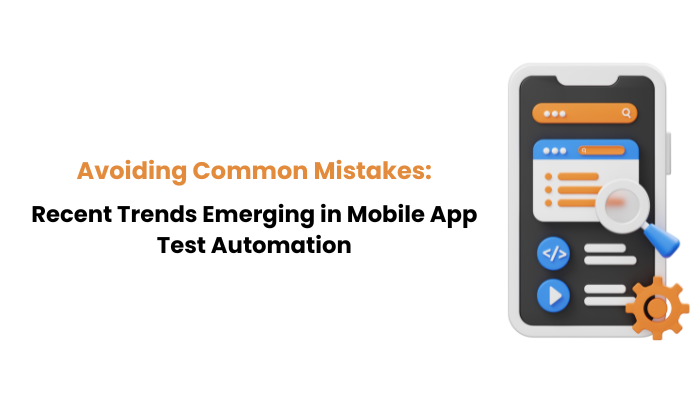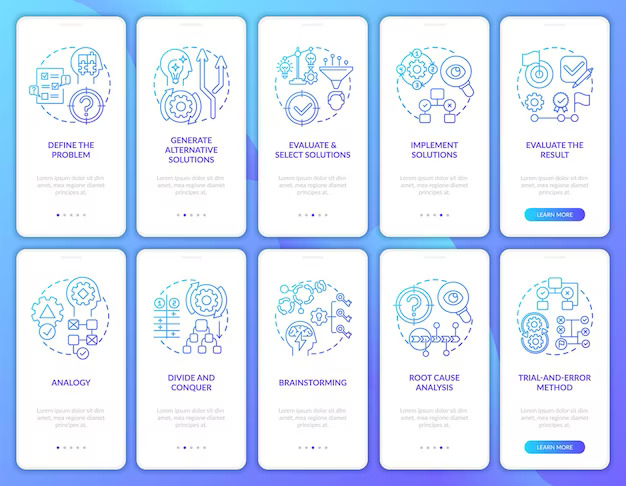Avoiding Common Mistakes: Recent Trends Emerging in Mobile App Test Automation

In today’s fast-paced digital landscape, where mobile applications play a pivotal role in connecting businesses with their customers, ensuring these apps are free from defects is paramount. Mobile app test automation emerges as a beacon of efficiency, propelling the quality assurance process to new heights.
By automating repetitive tasks, teams can focus on crafting innovative features rather than being bogged down by manual testing. This transformative approach not only accelerates the testing cycle but also significantly enhances the accuracy of the results, ensuring that the final product is of the highest quality.
The integration of mobile app test automation into the development lifecycle marks a strategic pivot from traditional manual testing methods. This evolution is driven by the complexity and variety of mobile devices, operating systems, and network conditions, which present a unique set of challenges for testers. Automation empowers teams to execute a wide array of tests simultaneously across different environments, a feat that would be virtually impossible to achieve manually in a timely manner.
Embracing mobile app test automation is not just about adopting new tools; it’s about a fundamental shift in mindset towards quality assurance. It requires a thorough understanding of both the potential benefits and the challenges involved. As we delve deeper into the nuances of mobile app test automation, let’s explore how it can transform the development process, the hurdles teams may encounter, and the best practices for successful implementation.

Benefits of Mobile App Test Automation
The adoption of mobile app test automation brings with it a plethora of benefits that can revolutionise the development process.
Firstly, it significantly reduces the time required for testing. Automated tests can be run unattended, often outside of business hours, which means that teams can arrive to work with test results waiting for them. This expedited feedback loop allows for quicker iterations and a more agile development process.
Moreover, test automation enhances the reliability of testing outcomes. Humans are prone to error, especially when performing monotonous tasks. Automated tests, on the other hand, execute the same steps with precision every time, ensuring consistent and accurate results. This reliability extends to the ability to execute a broader range of tests, including complex scenarios that might be challenging to assess manually.
Perhaps one of the most compelling advantages is the improved coverage that automation brings. Mobile apps must perform flawlessly across a myriad of devices, screen sizes, and operating systems. Automation enables comprehensive testing across all these variables, ensuring that the app delivers a consistent user experience regardless of the device.
Read this Article Also –iOS Automation Testing: Best Practices & Top Frameworks
Challenges in Mobile App Testing
Despite its advantages, mobile app test automation is not without challenges. The fragmentation of the mobile ecosystem is one of the foremost obstacles. With a multitude of devices, operating systems, and versions in the market, creating tests that cover all possible combinations can be daunting. This diversity requires a strategic approach to test planning and execution, often necessitating a significant initial investment in test infrastructure.
Another hurdle is the selection of the appropriate tools for automation. The market is flooded with a variety of tools, each with its own set of features, strengths, and limitations. Choosing the right tool requires a deep understanding of the application’s requirements and the technological landscape. It’s a decision that can have far-reaching implications on the effectiveness of the automation strategy.
Furthermore, maintaining automated tests can be resource-intensive. As the application evolves, so too must the automated tests. This maintenance requires ongoing attention to ensure that the tests remain relevant and effective. It’s a commitment that demands both time and skilled resources, which can be a challenge for teams already stretched thin.
The Importance of Test Automation in Mobile App Development
In the context of mobile app development, the importance of test automation cannot be overstated. It’s a critical component of a modern development strategy, enabling teams to meet the demands of rapid release cycles while maintaining high quality standards. Automation provides a scalable solution to testing that can adapt to the evolving landscape of mobile technology.
Test automation also plays a crucial role in supporting continuous integration/continuous deployment (CI/CD) practices. By integrating automated tests into the CI/CD pipeline, teams can automatically verify the quality of each build, ensuring that only thoroughly tested code is deployed. This integration is key to achieving a truly agile development process, where new features and fixes can be delivered to users with unprecedented speed and reliability.
Moreover, automation contributes to a better understanding of the app’s quality over time. Through detailed reporting and analytics, teams can identify trends, pinpoint recurring issues, and make informed decisions about where to focus their development efforts. This data-driven approach to quality assurance helps in prioritising tasks and allocating resources more effectively, ultimately leading to a more robust and reliable app.
Choosing the Right Tools for Mobile App Test Automation
Selecting the right tools is critical to the success of any mobile app test automation strategy. The ideal toolset should not only address the current needs of the project but also be scalable to accommodate future growth. It requires a balance between functionality, ease of use, and integration capabilities.
When evaluating tools, consider the languages and frameworks your team is already familiar with. A tool that aligns with your team’s expertise can significantly reduce the learning curve and accelerate the adoption process. Additionally, look for tools that offer comprehensive reporting and analytics features. These insights are invaluable for troubleshooting issues and improving test coverage over time.
Integration capabilities with other tools and systems in the development ecosystem are also a key consideration. The ability to seamlessly integrate with CI/CD pipelines, version control systems, and bug tracking tools can streamline workflows and enhance efficiency.
Best Practices for Mobile App Test Automation
To maximise the benefits of mobile app test automation, there are several best practices that teams should follow.
Firstly, it’s essential to start with a clear plan. Define the scope of automation, identify the key scenarios to automate, and establish measurable goals. This planning phase lays the foundation for a successful automation strategy.
Another best practice is to prioritise maintainability. Design tests in a modular and reusable manner, making it easier to update them as the app evolves. Employing page object models or similar design patterns can significantly reduce maintenance overhead.
Lastly, continuously evaluate and refine your automation strategy. As new tools emerge and the application landscape changes, what works today might not be as effective tomorrow. Stay informed about the latest trends and best practices, and be prepared to adapt your approach as necessary.
Key Considerations for Successful Mobile App Test Automation
For mobile app test automation to be successful, several key considerations must be taken into account. First and foremost is the commitment to quality throughout the development lifecycle. Automation should be seen as a complement to, not a replacement for, manual testing efforts. It’s crucial to maintain a balance between automated and manual testing to ensure comprehensive coverage.
Another consideration is the investment in infrastructure. Whether it’s physical devices or cloud-based device farms, having access to a diverse set of testing environments is essential for uncovering device-specific issues. This infrastructure must be supported by a robust network setup that can simulate different network conditions.
Finally, fostering a culture of collaboration between developers, testers, and other stakeholders is vital. Automation is most effective when there’s a shared understanding of its goals and benefits. Encouraging open communication and collaboration ensures that automation efforts are aligned with the overall project objectives.
Case Studies of Successful Mobile App Test Automation Implementation
Exploring case studies of successful mobile app test automation implementations can provide valuable insights and inspiration. One notable example is a leading e-commerce company that implemented a comprehensive automation strategy across its mobile platforms.
By integrating automated tests into their CI/CD pipeline, they were able to reduce their release cycle from weeks to days while improving the overall quality of their app.
Another example comes from a financial services company that faced challenges with device fragmentation.
By leveraging a cloud-based device farm and implementing a robust test automation framework, they achieved significant improvements in test coverage and efficiency, enabling them to confidently deliver their app across a wide range of devices.
These case studies highlight the transformative potential of mobile app test automation when strategically implemented. They underscore the importance of a well-thought-out approach, the right tools, and a commitment to quality.
Mobile App Test Automation Frameworks and Methodologies
There are various frameworks and methodologies available to guide mobile app test automation efforts. Popular frameworks like Selenium WebDriver and Appium offer wide support for mobile platforms, making them a go-to choice for many teams. Additionally, BDD (Behaviour Driven Development) methodologies, supported by tools like Cucumber, encourage collaboration and communication by allowing tests to be written in a human-readable format.
Choosing the right framework or methodology depends on several factors, including the application’s technology stack, the team’s expertise, and the specific requirements of the project. It’s often beneficial to experiment with different approaches to determine what works best for your team and project.
The Future of Mobile App Test Automation
Looking ahead, the future of mobile app test automation is poised for continued evolution. Advances in AI and machine learning are beginning to make their mark, offering new possibilities for enhancing testing efficiency and effectiveness. From predictive analytics that can suggest which tests to run, to intelligent test generation that can automatically create tests based on user interactions, these technologies hold the promise of further revolutionising mobile app test automation.
Moreover, the increasing complexity of mobile apps, coupled with the demand for faster release cycles, will drive the need for more sophisticated automation solutions. As the landscape evolves, staying abreast of the latest technologies and best practices will be crucial for maintaining a competitive edge.
Summing up
Mobile app test automation stands as a cornerstone of modern app development, offering a path to higher quality, efficiency, and user satisfaction. By understanding its benefits, navigating its challenges, and adhering to best practices, teams can leverage automation to its full potential.
As we look to the future, the continuous evolution of automation technologies promises to further enhance our ability to deliver exceptional mobile experiences. In this dynamic environment, embracing automation is not just a choice but a necessity for success.
Read More Blogs Explore This Website Also- hituponviews.com









